ZHCSDM7B February 2012 – December 2014 LMP8646
PRODUCTION DATA.
- 1 特性
- 2 应用
- 3 说明
- 4 修订历史记录
- 5 Pin Configuration and Functions
- 6 Specifications
- 7 Detailed Description
- 8 Application and Implementation
- 9 Power Supply Recommendations
- 10Layout
- 11器件和文档支持
- 12机械、封装和可订购信息
6 Specifications
6.1 Absolute Maximum Ratings
over operating free-air temperature range (unless otherwise noted)(1)(1)| MIN | MAX | UNIT | ||
|---|---|---|---|---|
| Supply Voltage (VS = V+ - V−) | 13.2 | V | ||
| Differential voltage +IN- (-IN) | 6 | V | ||
| Voltage at pins +IN, -IN | –6 | 80 | V | |
| Voltage at RG pin | 13.2 | V | ||
| Voltage at OUT pin | V- | V+ | V | |
| Junction Temperature(2) | 150 | °C | ||
| Storage temperature range | –65 | 150 | °C | |
| For soldering specifications see SNOA549 | ||||
6.2 ESD Ratings
| VALUE | UNIT | ||||
|---|---|---|---|---|---|
| V(ESD) | Electrostatic discharge | Human-body model (HBM), per ANSI/ESDA/JEDEC JS-001(1) | Pins +IN and -IN | ±4000 | V |
| All pins except +IN and -IN | ±2000 | ||||
| Charged-device model (CDM), per JEDEC specification JESD22-C101(2) | ±1250 | ||||
| Machine model | ±250 | ||||
(1) JEDEC document JEP155 states that 500-V HBM allows safe manufacturing with a standard ESD control process.
(2) JEDEC document JEP157 states that 250-V CDM allows safe manufacturing with a standard ESD control process.
6.3 Recommended Operating Conditions
| MIN | MAX | UNIT | ||
|---|---|---|---|---|
| Supply Voltage (VS = V+ - V−) | 2.7 | 12 | V | |
| Temperature Range(2) | –40 | 125 | V | |
6.4 Thermal Information
| THERMAL METRIC(1) | LMP8646 | UNIT | |
|---|---|---|---|
| DDC | |||
| 6 PINS | |||
| RθJA | Junction-to-ambient thermal resistance | 96 | °C/W |
(1) For more information about traditional and new thermal metrics, see the IC Package Thermal Metrics application report, SPRA953.
6.5 Electrical Characteristics: 2.7 V
Unless otherwise specified, all limits ensured for at TA = 25°C, VS= (V+ – V-) = (2.7 V - 0 V) = 2.7 V, −2 V < VCM < 76 V, RG= 25 kΩ, RL = 10 kΩ.(3)| PARAMETER | TEST CONDITIONS | MIN(5) | TYP(4) | MAX(5) | UNIT | |
|---|---|---|---|---|---|---|
| VOFFSET | Input Offset Voltage | VCM = 2.1 V | –1 | 1 | mV | |
| VCM = 2.1 V, –40°C ≤ TJ ≤ 125°C | –1.7 | 1.7 | ||||
| TCVOS | Input Offset Voltage Drift(6)(8) | VCM = 2.1 V | 7 | μV/°C | ||
| IB | Input Bias Current(9) | VCM = 2.1 V | 12 | 20 | μA | |
| eni | Input Voltage Noise(8) | f > 10 kHz, RG = 5 kΩ | 120 | nV/√Hz | ||
| VSENSE | Max Input Sense Voltage(8) | VCM = 12 V, RG = 5 kΩ | 600 | mV | ||
| Gain AV | Adjustable Gain Setting(8) | VCM = 12 V | 1 | 100 | V/V | |
| Gm | Transconductance = 1/RIN | VCM = 2.1 V | 200 | µA/V | ||
| Accuracy | VCM = 2.1 V | –2% | 2% | |||
| VCM = 2.1 V, –40°C ≤ TJ ≤ 125°C | –3.4% | 3.4% | ||||
| Gm drift(8) | −40°C to 125°C, VCM= 2.1 V | 140 | ppm /°C | |||
| PSRR | Power Supply Rejection Ratio | VCM = 2.1 V, 2.7 V < V+ < 12 V | 85 | dB | ||
| CMRR | Common-Mode Rejection Ratio | 2.1 V < VCM < 76 V | 95 | dB | ||
| –2 V <VCM < 2.1 V | 55 | |||||
| SR | Slew Rate(7)(8) | VCM = 5 V, CG = 4 pF, VSENSE from 25 mV to 175 mV, CL = 30 pF, RL = 1MΩ |
0.5 | V/µs | ||
| IS | Supply Current | VCM = 2.1 V | 380 | 610 | uA | |
| VCM = 2.1 V, –40°C ≤ TJ ≤ 125°C | 807 | |||||
| VCM = –2 V | 2000 | 2500 | ||||
| VCM = –2 V, –40°C ≤ TJ ≤ 125°C | 2700 | |||||
| VOUT | Maximum Output Voltage | VCM = 2.1 V, RG = 500 kΩ | 1.1 | V | ||
| Minimum Output Voltage | VCM = 2.1 V | 20 | mV | |||
| Maximum Output Voltage | VS = VCM = 3.3 V, RG = 500 kΩ | 1.6 | V | |||
| Minimum Output Voltage | VS = VCM = 3.3 V, RG = 500 kΩ | 22 | mV | |||
| IOUT | Output current(8) | Sourcing, VOUT= 600 mV, RG = 150 kΩ | 5 | mA | ||
| CLOAD | Max Output Capacitance Load(8) | 30 | pF | |||
6.6 Electrical Characteristics: 5 V
Unless otherwise specified, all limits ensured for at TA = 25°C, VS= V+-V-, V+ = 5 V, V− = 0 V, −2 V < VCM < 76 V, Rg= 25 kΩ, RL = 10 kΩ.(3)| PARAMETER | TEST CONDITIONS | MIN(5) | TYP(4) | MAX(5) | UNIT | |
|---|---|---|---|---|---|---|
| VOFFSET | Input Offset Voltage | VCM = 2.1 V | –1 | 1 | mV | |
| VCM = 2.1 V, –40°C ≤ TJ ≤ 125°C | –1.7 | 1.7 | ||||
| TCVOS | Input Offset Voltage Drift(6)(8) | VCM = 2.1 V | 7 | μV/°C | ||
| IB | Input Bias Current(9) | VCM = 2.1 V | 12.5 | 22 | μA | |
| eni | Input Voltage Noise(8) | f > 10 kHz, RG = 5 kΩ | 120 | nV/√Hz | ||
| VSENSE(MAX) | Max Input Sense Voltage(8) | VCM = 12 V, RG = 5 kΩ | 600 | mV | ||
| Gain AV | Adjustable Gain Setting(8) | VCM = 12 V | 1 | 100 | V/V | |
| Gm | Transconductance = 1/RIN | VCM = 2.1 V | 200 | µA/V | ||
| Accuracy | VCM = 2.1 V | –2% | 2% | |||
| VCM = 2.1 V, –40°C ≤ TJ ≤ 125°C | –3.4% | 3.4% | ||||
| Gm drift(8) | −40°C to 125°C, VCM= 2.1 V | 140 | ppm /°C | |||
| PSRR | Power Supply Rejection Ratio | VCM = 2.1 V, 2.7 V < V+ < 12 V, | 85 | dB | ||
| CMRR | Common-Mode Rejection Ratio | 2.1 V <VCM < 76 V | 95 | dB | ||
| –2 V < VCM < 2.1 V | 55 | |||||
| SR | Slew Rate(7)(8) | VCM = 5 V, CG = 4 pF, VSENSE from 100 mV to 500 mV, CL = 30 pF, RL= 1MΩ |
0.5 | V/µs | ||
| IS | Supply Current | VCM = 2.1 V | 450 | 660 | uA | |
| VCM = 2.1 V, –40°C ≤ TJ ≤ 125°C | 939 | |||||
| VCM = –2 V | 2100 | 2800 | ||||
| VCM = –2 V, –40°C ≤ TJ ≤ 125°C | 3030 | |||||
| VOUT | Maximum Output Voltage | VCM = 5 V, RG= 500 kΩ | 3.3 | V | ||
| Minimum Output Voltage | VCM = 2.1 V | 22 | mV | |||
| IOUT | Output current(8) | Sourcing, VOUT= 1.65 V, RG = 150 kΩ | 5 | mA | ||
| CLOAD | Max Output Capacitance Load(8) | 30 | pF | |||
6.7 Electrical Characteristics: 12 V
Unless otherwise specified, all limits ensured for at TA = 25°C, VS= V+ - V-, V+ = 12 V, V− = 0 V, −2 V < VCM < 76 V, Rg= 25 kΩ, RL = 10 kΩ.(3)| PARAMETER | TEST CONDITIONS | MIN(5) | TYP(4) | MAX(5) | UNIT | |
|---|---|---|---|---|---|---|
| VOFFSET | Input Offset Voltage | VCM = 2.1 V | –1 | 1 | mV | |
| VCM = 2.1 V, –40°C ≤ TJ ≤ 125°C | –1.7 | 1.7 | ||||
| TCVOS | Input Offset Voltage Drift(6)(8) | VCM = 2.1 V | 7 | μV/°C | ||
| IB | Input Bias Current(9) | VCM = 2.1 V | 13 | 23 | μA | |
| eni | Input Voltage Noise(8) | f > 10 kHz, RG = 5 kΩ | 120 | nV/√Hz | ||
| VSENSE(MAX) | Max Input Sense Voltage(8) | VCM =12 V, RG = 5 kΩ | 600 | mV | ||
| Gain AV | Adjustable Gain Setting(8) | VCM = 12 V | 1 | 100 | V/V | |
| Gm | Transconductance = 1/RIN | VCM = 2.1 V | 200 | µA/V | ||
| Accuracy | VCM = 2.1 V | –2% | 2% | |||
| VCM = 2.1 V, –40°C ≤ TJ ≤ 125°C | –3.4% | 3.4% | ||||
| Gm drift(8) | −40°C to 125°C, VCM =2.1 V | 140 | ppm /°C | |||
| PSRR | Power Supply Rejection Ratio | VCM = 2.1 V, 2.7 V < V+ < 12 V | 85 | dB | ||
| CMRR | Common-Mode Rejection Ratio | 2.1 V < VCM < 76 V | 95 | dB | ||
| –2 V < VCM < 2.1 V | 55 | |||||
| SR | Slew Rate(7)(8) | VCM = 5 V, CG = 4 pF, VSENSE from 100 mV to 500 mV, CL = 30 pF, RL=1 MΩ |
0.6 | V/µs | ||
| IS | Supply Current | VCM = 2.1 V | 555 | 845 | uA | |
| VCM = 2.1 V, –40°C ≤ TJ ≤ 125°C | 1123 | |||||
| VCM = –2 V | 2200 | 2900 | ||||
| CM = –2 V, –40°C ≤ TJ ≤ 125°C | 3110 | |||||
| VOUT | Maximum Output Voltage | VCM = 12 V, RG= 500 kΩ, | 10 | V | ||
| Minimum Output Voltage | VCM = 2.1 V | 24 | mV | |||
| IOUT | Output current(8) | Sourcing, VOUT= 5.25 V, RG = 150 kΩ | 5 | mA | ||
| CLOAD | Max Output Capacitance Load(8) | 30 | pF | |||
(1) Absolute Maximum Ratings indicate limits beyond which damage to the device may occur. Recommended Operating Conditions indicate conditions for which the device is intended to be functional, but specific performance is not ensured. For ensured specifications and the test conditions, see the Electrical Characteristics: 2.7 V tables.
(2) The maximum power dissipation must be derated at elevated temperatures and is dictated by TJ(MAX), θJA, and the ambient temperature, TA. The maximum allowable power dissipation PDMAX = (TJ(MAX) - TA)/ θJA or the number given in Absolute Maximum Ratings, whichever is lower.
(3) Electrical Table values apply only for factory testing conditions at the temperature indicated. Factory testing conditions result in very limited self-heating of the device such that TJ = TA. No assurance of parametric performance is indicated in the electrical tables under conditions of internal self-heating where TJ > TA.
(4) Typical values represent the most likely parametric norm at the time of characterization. Actual typical values may vary over time and will also depend on the application and configuration. The typical values are not tested and are not specified on shipped production material.
(5) All limits are specified by testing, design, or statistical analysis.
(6) Offset voltage temperature drift is determined by dividing the change in VOS at the temperature extremes by the total temperature change.
(7) The number specified is the average of rising and falling slew rates and measured at 90% to 10%.
(8) This parameter is specified by design and/or characterization and is not tested in production.
(9) Positive Bias Current corresponds to current flowing into the device.
6.8 Typical Characteristics
Unless otherwise specified: TA = 25°C, VS= V+ - V-, VSENSE= +IN - (-IN), RL = 10 kΩ.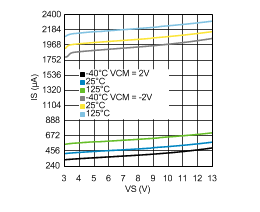 Figure 1. Supply Curent vs. Supply Voltage for VCM = 2 V
Figure 1. Supply Curent vs. Supply Voltage for VCM = 2 V
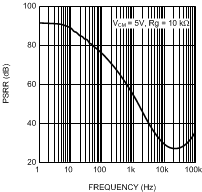 Figure 3. AC PSRR vs. Frequency
Figure 3. AC PSRR vs. Frequency
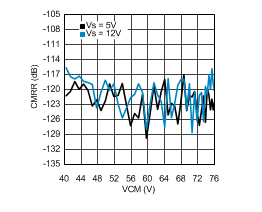 Figure 5. CMRR vs. High VCM
Figure 5. CMRR vs. High VCM
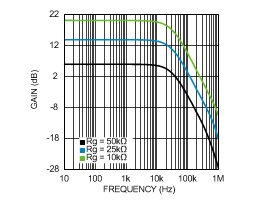 Figure 7. Gain vs. Frequency (BW = 35 kHz)
Figure 7. Gain vs. Frequency (BW = 35 kHz)
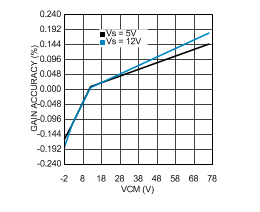 Figure 9. Gain Accuracy vs. VCM
Figure 9. Gain Accuracy vs. VCM
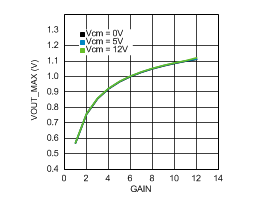 Figure 11. VOUT_MAX vs. Gain at Vs = 2.7 V
Figure 11. VOUT_MAX vs. Gain at Vs = 2.7 V
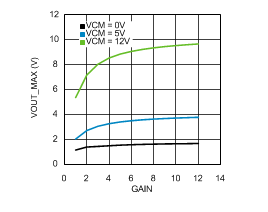 Figure 13. VOUT_MAX vs. Gain at Vs = 12 V
Figure 13. VOUT_MAX vs. Gain at Vs = 12 V
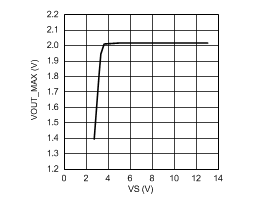 Figure 15. VOUT_MAX vs. VS at VCM = 2.1 V
Figure 15. VOUT_MAX vs. VS at VCM = 2.1 V
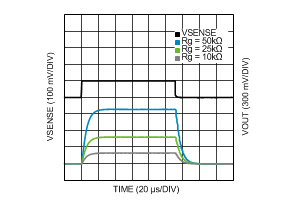 Figure 17. Large Step Response at BW = 35 kHz
Figure 17. Large Step Response at BW = 35 kHz
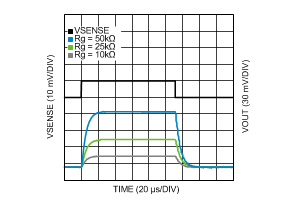 Figure 19. Small Step Response at BW = 35 kHz
Figure 19. Small Step Response at BW = 35 kHz
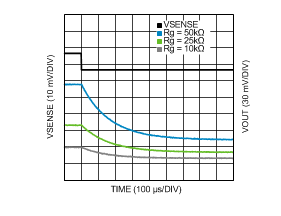 Figure 21. Settling Time (Fall) at 1 kHz
Figure 21. Settling Time (Fall) at 1 kHz
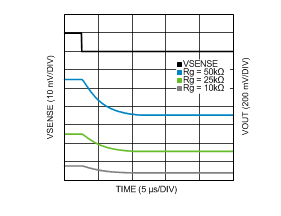 Figure 23. Settling Time (Fall) at 35 kHz
Figure 23. Settling Time (Fall) at 35 kHz
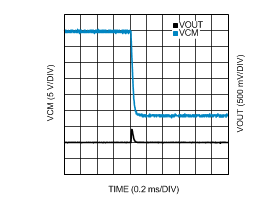 Figure 25. Common-Mode Step Response (Fall) at 35 kHz
Figure 25. Common-Mode Step Response (Fall) at 35 kHz
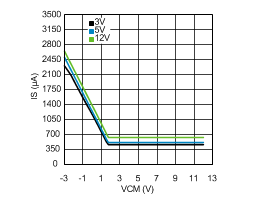 Figure 2. Supply Current vs. VCM
Figure 2. Supply Current vs. VCM
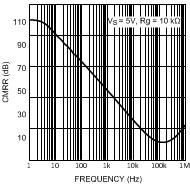 Figure 4. AC CMRR vs. Frequency
Figure 4. AC CMRR vs. Frequency
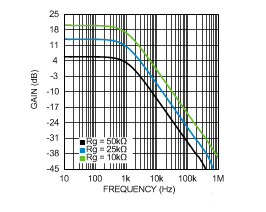 Figure 6. Gain vs. Frequency (BW = 1kHz)
Figure 6. Gain vs. Frequency (BW = 1kHz)
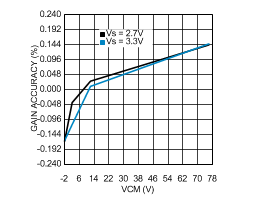 Figure 8. Gain Accuracy vs. VCM
Figure 8. Gain Accuracy vs. VCM
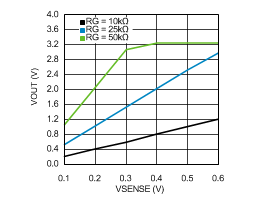 Figure 10. VOUT vs. VSENSE
Figure 10. VOUT vs. VSENSE
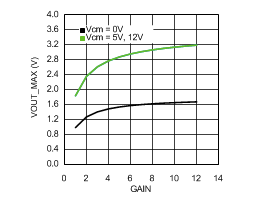 Figure 12. VOUT_MAX vs. Gain at Vs = 5.0 V
Figure 12. VOUT_MAX vs. Gain at Vs = 5.0 V
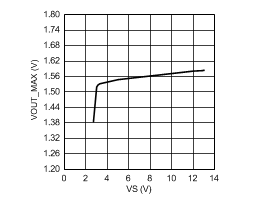 Figure 14. VOUT_MAX vs. VS at VCM = –2 V
Figure 14. VOUT_MAX vs. VS at VCM = –2 V
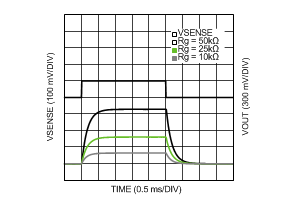 Figure 16. Large Step Response at BW = 1kHz
Figure 16. Large Step Response at BW = 1kHz
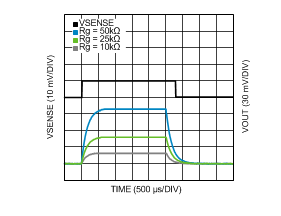 Figure 18. Small Step Response at BW = 1 kHz
Figure 18. Small Step Response at BW = 1 kHz
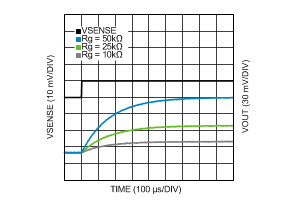 Figure 20. Settling Time (Rise) at 1 kHz
Figure 20. Settling Time (Rise) at 1 kHz
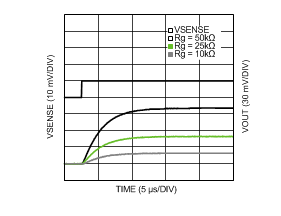 Figure 22. Settling Time (Rise) at 35 kHz
Figure 22. Settling Time (Rise) at 35 kHz
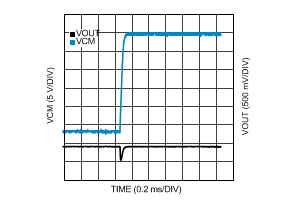 Figure 24. Common-Mode Step Response (Rise) at 35 kHz
Figure 24. Common-Mode Step Response (Rise) at 35 kHz